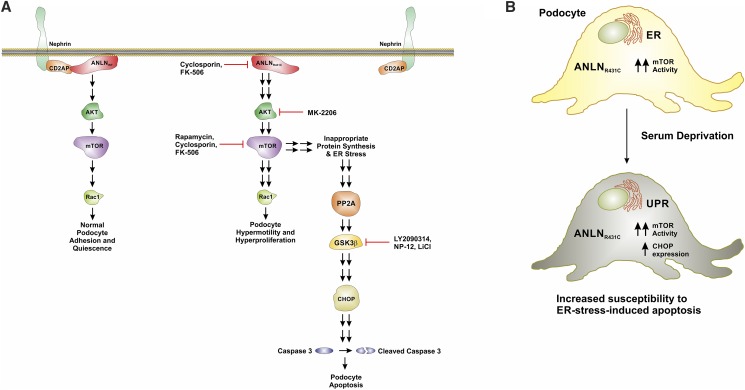Figure 8.
The R431C mutation induces hyperproliferation, hypermotility and ER stress-induced apoptosis in podocytes. (A) In healthy podocytes, ANLN modulates actin cytoskeletal dynamics at the slit diaphragm and facilitates prosurvival signaling through the phosphoinositide 3-kinase (PI3K)/AKT signaling pathway. The ANLN interaction with CD2-associated protein (CD2AP) is essential to these functions. The R431C mutation disrupts the ANLN-CD2AP interaction, producing (1) dysregulated F-actin polymerization and bundling, (2) hyperactivation of the PI3K/AKT/mTOR/p70S6K/Rac1 signaling axis, and (3) activation of endoplasmic reticulum (ER) stress–induced apoptosis. Specifically, the R431C mutation distorts the secondary structure of ANLN at the F-actin binding domain (Figure 2), which impairs F-actin polymerization and bundling in podocytes. These changes alter podocyte foot process architecture at the slit diaphragm, contributing to the development of proteinuria.7 The R431C mutation also disrupts the ANLN-CD2AP interaction through distortion of the CD2-associated protein binding region (Figure 2). This uncoupling further impairs F-actin cytoskeletal dynamics and alters podocyte prosurvival signaling through the PI3K/AKT signaling pathway. Hyperactivation of the PI3K/AKT/mTOR/p70S6K/Rac1 axis enhances Rac1-mediated cytoskeletal remodeling, contributing to distortion of foot process architecture. Additionally, increased Rac1 activity induces activation of the transcriptional regulator Signal Transducer and Activator of Transcription 3 (Figure 4), which promotes podocyte proliferation. In a parallel process, the hyperactivation of mTOR induces ER stress. ER stress promotes the upregulation of calcineurin phosphatase (Cn) activity. Cn dephosphorylates/activates glycogen synthase kinase 3β (GSK-3β), which activates C/EBP homologous protein (CHOP) expression in the context of ER stress. Activation of CHOP induces caspase 3–mediated apoptotic signaling. The loss-of-function effect of the R431C mutation in vivo likely reflects the effect of R431C-induced podocyte apoptosis. R431C-induced apoptosis is attenuated by inhibition of PI3K, AKT, mTOR, GSK-3β, and Cn in vitro. (B) The R431C mutation causes podocyte dysfunction through hyperactivation of PI3K/AKT/mTOR signaling and induces podocyte apoptosis through activation of mTOR-driven ER stress. PP2A, Protein Phosphatase 2A.

